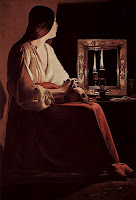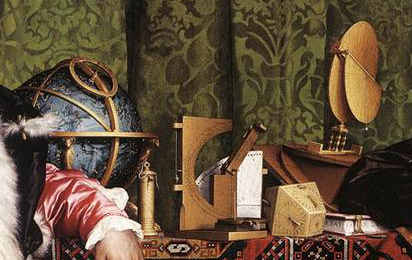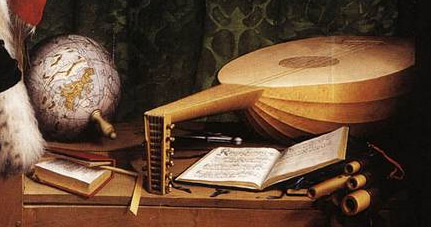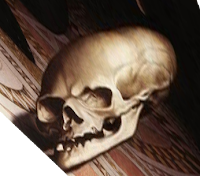It is interesting that throughout art history we can find one artist who will paint multiple versions of the same painting- why is this? There are many reasons but usually the first version of the painting was so successful that the artist had received another commission. Let's look at several well known versions of the same theme by the same artist.
1483, Louvre (left) and 1506, The National Gallery (London) (right)
The Virgin of the Rocks, Leonardo da Vinci
Leonardo da Vinci created this new type of Madonna and Child painting when he first moved to Milan. The figures aren't seated on a throne or a chair, but enclosed in a unique landscape which seems otherworldly. The Virgin Mary puts her arm around the infant St. John the Baptist as he is given the sign of benediction by the infant Christ while being watched over by an angel. A foreshadowing to Christ's baptism by St. John can be seen in the body of water in the foreground. Leonardo is here using several techniques he is famous for: chiaroscuro (modeling form with lights and darks), sfumato (using this glazes of paint like smoke) and the use of atmospheric perspective in the blue-gray landscape in the distant background. The gestures, colors and forms all act as symbols as Leonardo took great care to copy this painting nearly exactly in the second version.
Why two versions of this painting? The web site of the Louvre museum has a good hypothesis regarding the two versions of Leonardo's Virgin of the Rocks. The following text is taken from the website and was written by Séverine Laborie:
"The Louvre version of the picture was to have been the central part of a polyptych which the Brotherhood of the Immaculate Conception commissioned Leonardo and the de Predis brothers to paint for a chapel in the church of San Francesco Grande in Milan in 1483. The other version, now in the National Gallery in London and known to have formerly been in this chapel, and several archive documents indicate that the Louvre painting was never installed there. Its presence in the French royal collection is attested from1627, but several clues suggest it may have been acquired much earlier.
The most convincing hypothesis is that the picture, painted between 1483 and 1486, did not meet with Leonardo’s clients’ full satisfaction, which enabled Louis XII to acquire it around 1500−1503. The second, replacement picture, now in London, may have been painted by Ambrogio de Predis under Leonardo’s supervision between 1495 and 1508."
1528, Metropolitan Museum of Art (left) and 1530, St. Louis Art Museum (right)
The Judgment of Paris, Lucas Cranach the Elder
German artist Lucas Cranach the Elder was a court painter in Saxony and above we see two versions of The Judgment of Paris. This told a story from the start of the Trojan War where the shepherd Paris had to judge which of three Greek goddesses was the most beautiful. Cranach made several versions of this theme, he depicts the goddess as young and lithe (if proportionally inaccurate) and shows Paris dressed as a Renaissance man. This was a popular theme for a few reasons: it showed the patron was educated and had knowledge of the classics and it depicted beautiful women. Yet there was another reason this story was popular among Cranach’s patrons. The Metropolitan Museum of Art states on their website:
“Just as the emperor Augustus had claimed descent from Aeneas, a son of Venus, so many Italian princes traced their ancestry to the participants in the Trojan War or sought to equate their own accomplishments with the deeds of these heroes.”*
*Source of quote: Heroes in Italian Mythological Prints | Thematic Essay |Heilbrunn Timeline of Art History | The Metropolitan Museum of Art
Supper at Emmaus, Caravaggio, 1601, The National Gallery (London)
The Italian Baroque painter Caravaggio has a few examples of multiple versions of the same painting. His two versions of Christ's Supper at Emmaus are unique in this blog entry as being quite different from one another.
A Roman nobleman Ciriaco Mattei, commissioned the earlier version (above) in 1601. In this first version Caravaggio pays as much attention to the detailed still-life objects on the table as to his figures. The gestures that each figure makes are quite theatrical, Christ is shown as clean shaven and this version is not as dark. In fact a figure casts a shadow that seems to represent a halo over the head of Christ. While this is a well done painting, it isn't as realistic as his later version.
The second version of this painting was done after Caravaggio committed murder and fled to Naples. Today it hangs in the Brera Gallery in Milan where I was fortunate enough to have recently seen it, in fact I spent quite a long time sitting in front of this painting. This later version is more somber and powerful for the viewer, the figures appear in a naturalistic way rather than as having been posed dramatically for the scene. The sobering changes in the artist's own life are clearly reflected in this work, done in 1606.
Supper at Emmaus, Caravaggio, 1606, Brera Gallery, Milan


Vanitas Still-Life, Pieter Claesz Vanitas Still-Life, Pieter Claesz
1630, Mauritshuis, Holland 1656, Kunsthistoriches Museum, Vienna
Seventeenth century Dutch painter Pieter Claesz was a prolific artist who specialized in the Vanitas painting. In Latin Vanitas means vanity and the Vanitas painting uses symbols to reflect on mortality. The message for the viewer was a reminder that while earthly life is fleeting, your soul is eternal. While variations of the Vanitas had been used for centuries, its rise in Dutch art coincided with a difficult time in the countries history. The Twelve Years Truce with Spain ended in 1621 and much of the next decade was spent under siege. In 1624 a plague swept through Holland, the plague returned in 1635 and struck most heavily in Leiden where over 14,000 died.
The Vanitas painting became increasing popular through the 1620’s and went from being metaphorical to an allegory of death. Symbols of mortality included: skulls, candles (both lit and extinguished), timepieces, extinguished oil lamps and empty hourglasses. Claesz painted many versions of Vanitas paintings as they were a popular style of painting and middle and upper class patrons were buying these from galleries to display in their homes.
The Penitent Magdalene, Georges de la Tour
French artist Georges de la Tour paints another version of the Vanitas, the penitent Mary Magdalene reflecting on her sins. He owed much of his style to that of Caravaggio and is considered a "Caravaggisti" or one of Caravaggio's stylistic followers. de la Tour painted at least four versions of this work, The Repentant Magdalene, is now housed in the National Gallery of Art (DC) and The Magdalene with the Smoking Flame, at the LACMA.
This was typical for the artist, he also painted multiple versions of other themes during his career.
This was typical for the artist, he also painted multiple versions of other themes during his career.
Like the Claesz paintings we have symbols of mortality, such as the skull and the candle. There are also other symbols of earthly vanity such as jewelry. Like Caravaggio he creates a somber mood with a strong light source, all four versions of this painting are illuminated by a single candle. Though the earliest version is unique in that the flame of the candle is reflected in a mirror that Mary Magdalene looks into with a meditative gaze. Like Pieter Claesz, Georges de la Tour was also selling his work for a broad market and therefore would paint additional versions of his paintings that were the most popular.
Painting Gallery of Ancient Rome, Pannini, 1758, Louvre
Giovanni Paolo Pannini painted his famous pair of works: Painting Gallery of Ancient Rome and Painting Gallery of Modern Rome while he was the professor of perspective at the French Academy of Rome. French painter Hubert Robert began working in his studio and Pannini was to become the biggest influence on his artistic style. Pannini took on the role of a mentor for Robert and the younger artist proclaimed him to be the greatest painter of ruins in the world. While under his supervision Robert assisted with the master’s well known first version of his paintings of imaginary gallery views of ancient and modern Rome, of which he would make several other versions. The first version was commissioned in 1756 by the Comte de Stainville (the future Duc de Choiseul) who had himself and his friends painted into the scenes as visitors to the galleries. This pair of paintings proved to be so popular with de Stainville that the year after he finished them Pannini created a second set of these paintings again for the Comte, now in the Louvre. Robert himself owned a later third version of Pannini’s gallery view paintings as well as several other works by him.
Painting Gallery of Ancient Rome, Pannini, 1756-57, Stuttgart, Germany
These are just a handful of examples of multiple versions of the same painting by the same artist, but many more can be found throughout history.
















